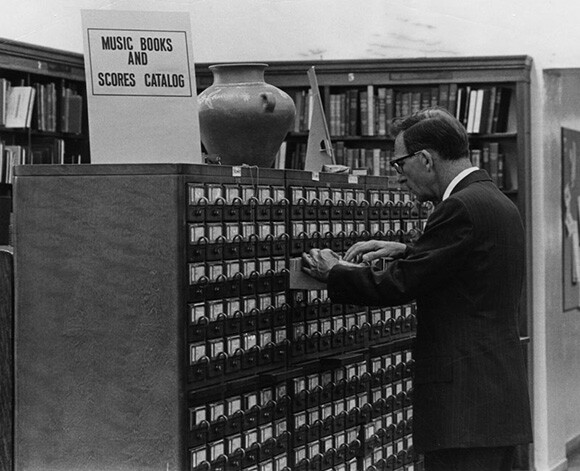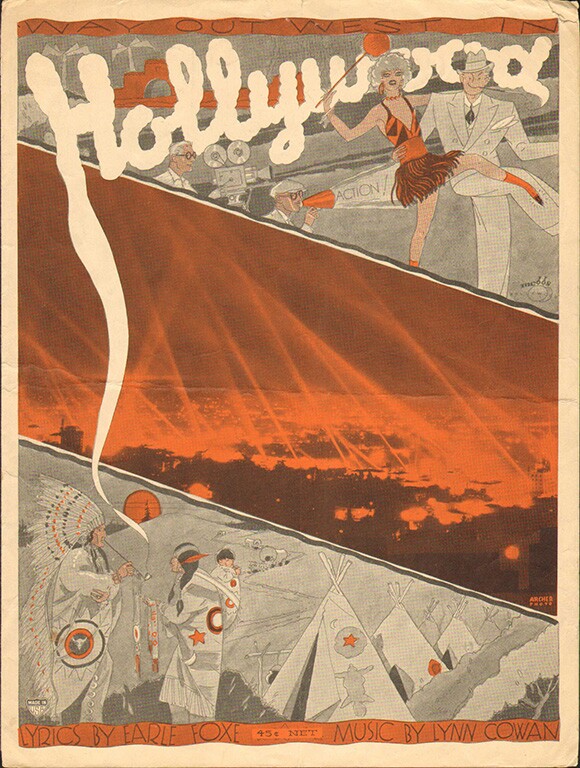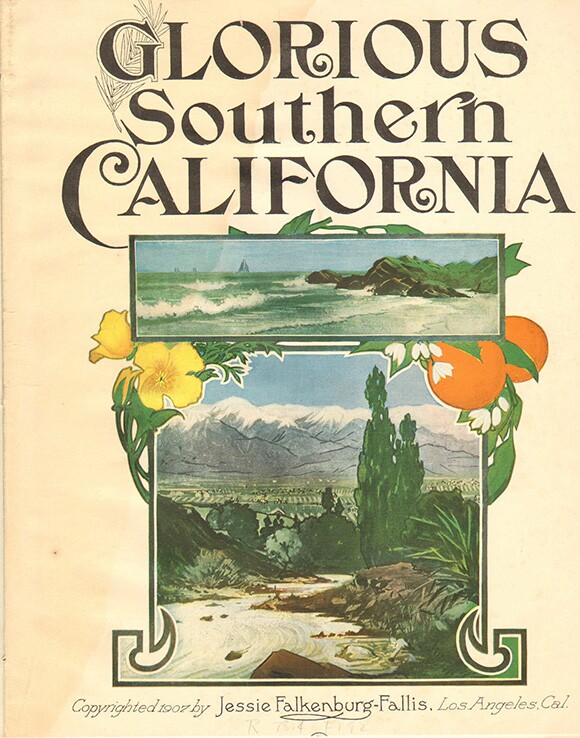Songs in the Key of Los Angeles: A Prelude
In partnership with The Library Foundation of Los Angeles to support and enrichthe capabilities, resources, and services of the Los Angeles Public Library.
Songs in the Key of L.A. is a multi-platform collaboration between the Library Foundation of Los Angeles, the Los Angeles Public Library, and USC professor Josh Kun that brings to life the Library's extraordinary Southern California Sheet Music Collection. Five L.A. artists were invited to pick some sheet music, study it, and then interpret it in any style of their choosing. The finished products are now available for free download from the website of the Los Angeles Public Library, and Artbound produced short documentaries on the process.
What does it mean to sing a song of Los Angeles?
Over a year of Saturdays, that was probably the biggest question that we brought with us into the stacks of the downtown Central Library as we scoured, white-gloved, through hundreds of boxes of loose sheet music in order to hunt down the lost musical archive of our city. But there were others as well: What is the point of a physical archive in the age of Pinterest and Tumblr? What can the music of the past tell us about the music of the present? How did songs help build L.A.? And what's up with all the ukelele and piano arrangements for waltzes and marches about oranges, roses, and poppies?
In 2010, when Ken Brecher took over as president of the Library Foundation of Los Angeles -- the private entity that raises funds for the Los Angeles Public Library -- one of his goals was to work with librarians, scholars, and artists throughout the city to invigorate the rich and voluminous collections of the library. He started talking about it as "mining the library," casually proselytizing about intrepid idea discoverers rappelling and spelunking through the stacks with carbide lamps strapped to their heads. "There are over 50,000 pieces of sheet music here at the Central Library," Brecher told me, "Why don't you be one of our miners?" I gladly strapped on my headlamp, and brought a team of my USC Annenberg students with me.

Our mining yielded a quick find. Buried amidst the over 50,000 individual pieces of sheet music and over 50,000 individual songbooks were songs that had something to do with Los Angeles and Southern California. There were city anthems like "Los Angeles the Beautiful" and "Los Angeles, Los Angeles, I Wish I'd Come Before," regional peans like "Glorious Southern California" and "Make Your Mind Up to Wind Up in Sunny California," songs for L.A. restaurants (The Paris Inn, Cafe Caliente), songs for Venice Beach, Palos Verdes, and the San Fernando Valley (the one Bing Crosby famously packed his grip for), and songs for tourist attractions (Catalina Island gets a lot of musical love).
There were songs that featured local regulars like Abe Lyman and His Ambassador Orchestra and Rube Wolff and His Greater Band Loew's State Theatre Los Angeles, and songs penned by some of Southern California's greatest early songwriters like Carrie Jacobs-Bond, whose 1909 hit "A Perfect Day" was written in a room in Riverside's Mission Inn, inspired by the cross atop Mt. Rubidoux. There were the familiar ("California, Here I Come" and "Hooray for Hollywood") and the unexpected ("The Fighting Fifteenth," a 1918 war stomper for the 15th Separate Company California Infantry).


We found what might be the first song published about Los Angeles (1876's "The Wines of Los Angeles County") and what might be the first song ever to be commissioned by a columnist for the Los Angeles Times (1959's "Angeltown"). We found that "I Love You California," the official song of the state of California that is now an ad for Jeep Grand Cherokee, was a product of the L.A. music scene, penned by Abraham Frankenstein, the musical director of the Orpheum Theatre Orchestra, and Francis Silverwood, who was best known for a downtown clothing emporium. The collection was loaded with evidence of just how influential Mexican musicians and Mexican musical traditions have been on shaping the city's sounds, and gospel and jazz sheet music -- not to mention the pop classic "When The Swallows Come Back To Capistrano," written by black songwriter and publisher Leon Rene -- which offered windows into the long legacy of independent black music publishing and industry in Southern California.
Slowly, a SoCal sheet music taxonomy began to emerge: The Sunshine and Oranges song; The You Have No Idea How Badly You Need To Come To California song; The I Was in California But I Left and Boy I Should Never Have Left California song; The My Love Lives in California song; The You Will Find Your Love in California and You Will Compare Her To A Rose or a Poppy song; The Mission Bells Are Chiming For A Fantasy Spanish Past in Old California song; and the This Is Really Just A Jingle for a Furniture Store or a Hotel So After You Buy the Sheet Music Please Come Book a Room or Buy A Piano song.
What also began to emerge was a clear portrait of an early bustling Los Angeles music industry that has been rarely commented upon. Most histories of popular music in Los Angeles give the impression that there was nothing going on here before the 1940s--before the labels opened up shop, before Hollywood was in full swing, before Central Avenue was really jumping -- but the Library's sheet music collection reveals a thriving scene of independent music publishers, theaters and vaudeville houses, and music stores, all mostly centered downtown. The Southern California Music Company had four stories of merchandise on Broadway, Bartlett's Music Store was nearby on First, and on Spring in the late 1800s was Tally's Phonograph Parlor, the first "record" store in Los Angeles where you could play "automatic phonograph machines" for a nickel a song and come in to record a song of your own.
Once our mining yielded these results, however, we wanted it to live. What is an archive if nobody uses it? So we compiled some of the collection's signature pieces into a book, Songs in the Key of Los Angeles (to be published June 1 byAngel City Press), and we will be featuring others in a July exhibition at the Central Library back where it all started. The Library will also host special performances in which the sheet music will come alive in the hands of the GRAMMY-winning L.A. band Quetzal and L.A. icon Van Dyke Parks (his musings on the song "Home in Pasadena" are also featured in our book), and in August, hometown favorites and authors of their own "City of Angels" anthem Ozomatli will explore the collection in a two-hour public concertas part of the venerable Grand Performances concert series.

Because so much of the sheet music in the Library's collection had never been recorded before, we also decided to take a few pieces into the recording studio. Bedrock L.A. generously donated some studio time with engineers Tyler Gardin and Eric Rennaker and we invited five L.A. artists representing a range of sounds, scenes and genres -- Aloe Blacc, La Santa Cecilia, Julia Holter, I See Hawks in L.A., The Petrojvic Blasting Company -- to pick some sheet music, study it, and then interpret it in any style of their choosing. The finished products are now available for free download from the website of the Los Angeles Public Library.
Luckily the Artbound cameras were on hand to document each session. Check back here every two weeks for an intimate behind-the-scenes look at what happens when the early 1900s meet the early 2000s, when sheet music comes alive to create a new generation of songs written, and now recorded, in the key of Los Angeles.
Courtesy of Victoria Dailey, loan to Los Angeles Public Library
For our first Bedrock session, we are proud to present local California country stalwartsI See Hawks in L.A. taking on 1904's "In The Valley of the San Joaquin," a beautiful piece of sheet music generously shared with the project by veteran Los Angeles collector Victoria Dailey. Written by John J. Cooke and S. Arthur Nichols, the song was published in Los Angeles by Robert E. Larkins. If any recordings were ever previously made of the song, none seem to exist, which makes this session particularly memorable-- a rare chance to hear this tale of longing for orange groves and blooming roses come back to life.
Like the song? Here's a free download of I See Hawks in L.A. performing "In the Valley of the San Joaquin".




The Bedrock Sessions were made possible by the generous support of Bedrock.LA, The Library Foundation of Los Angeles, & The Norman Lear Center.

Dig this story? Sign up for our newsletter to get unique arts & culture stories and videos from across Southern California in your inbox. Also, follow Artbound on Facebook and Twitter.


